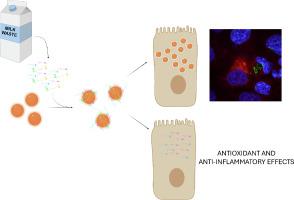从食物垃圾中提取生物活性肽:提高细胞吸收和生物效应的新型创新生物纳米复合物
IF 5.4
2区 医学
Q2 MATERIALS SCIENCE, BIOMATERIALS
引用次数: 0
摘要
乳腺炎是最重要的牛病,给全球乳业造成了巨大的经济损失。本研究通过一种新颖的分离方法,探讨了从患有乳腺炎的奶牛身上提取乳清的价值。利用表面活性磁铁矿纳米颗粒(SAMNs)作为磁性诱饵,选择性地结合具有潜在健康益处的生物活性肽。HPLC 和 LC-MS/MS 等先进技术突显了 SAMN 分离受限肽群的能力,与对照组(固相萃取,SPE)的情况大相径庭,并以特殊的酸性残留物分布为特征。最重要的是,在对 Caco-2 细胞进行测试时,磁性纯化肽和纳米固定肽(SAMN@肽)都显示出对氧化应激和炎症的保护活性;SAMN@肽具有最强的生物效应。SAMNs 具有优异的特性,它们在环境上是可持续的,而且其合成具有成本效益,这促使其成为捕获生物活性肽的一种可扩展、可选择性的工具,在功能食品和营养保健品中具有潜在的应用价值。本文章由计算机程序翻译,如有差异,请以英文原文为准。

Bioactive peptides from food waste: New innovative bio-nanocomplexes to enhance cellular uptake and biological effects
Mastitis is the most important bovine disease, causing dramatic economic losses to the dairy industry, worldwide. This study explores the valorization of whey from cows affected by mastitis, through a novel separation approach. Surface Active Maghemite Nanoparticles (SAMNs) were used as magnetic baits to selectively bind bioactive peptides with potential health benefits. Advanced techniques such as HPLC and LC-MS/MS highlighted SAMN capability of isolating a restricted group of peptides, drastically diverging from the control profile (Solid Phase Extraction, SPE) and characterized by a peculiar acidic residue distribution. Most importantly, both magnetically purified and nano-immobilized peptides (SAMN@peptides) showed protective activity against oxidative stress and inflammation, when tested on Caco-2 cells; with SAMN@peptides being associated with the strongest biological effect. SAMNs exhibited excellent characteristics, they are environmentally sustainable, and their synthesis is cost-effective prompting at a scalable and selective tool for capturing bioactive peptides, with potential applications in functional foods and nutraceuticals.
求助全文
通过发布文献求助,成功后即可免费获取论文全文。
去求助
来源期刊

ACS Biomaterials Science & Engineering
Materials Science-Biomaterials
CiteScore
10.30
自引率
3.40%
发文量
413
期刊介绍:
ACS Biomaterials Science & Engineering is the leading journal in the field of biomaterials, serving as an international forum for publishing cutting-edge research and innovative ideas on a broad range of topics:
Applications and Health – implantable tissues and devices, prosthesis, health risks, toxicology
Bio-interactions and Bio-compatibility – material-biology interactions, chemical/morphological/structural communication, mechanobiology, signaling and biological responses, immuno-engineering, calcification, coatings, corrosion and degradation of biomaterials and devices, biophysical regulation of cell functions
Characterization, Synthesis, and Modification – new biomaterials, bioinspired and biomimetic approaches to biomaterials, exploiting structural hierarchy and architectural control, combinatorial strategies for biomaterials discovery, genetic biomaterials design, synthetic biology, new composite systems, bionics, polymer synthesis
Controlled Release and Delivery Systems – biomaterial-based drug and gene delivery, bio-responsive delivery of regulatory molecules, pharmaceutical engineering
Healthcare Advances – clinical translation, regulatory issues, patient safety, emerging trends
Imaging and Diagnostics – imaging agents and probes, theranostics, biosensors, monitoring
Manufacturing and Technology – 3D printing, inks, organ-on-a-chip, bioreactor/perfusion systems, microdevices, BioMEMS, optics and electronics interfaces with biomaterials, systems integration
Modeling and Informatics Tools – scaling methods to guide biomaterial design, predictive algorithms for structure-function, biomechanics, integrating bioinformatics with biomaterials discovery, metabolomics in the context of biomaterials
Tissue Engineering and Regenerative Medicine – basic and applied studies, cell therapies, scaffolds, vascularization, bioartificial organs, transplantation and functionality, cellular agriculture
 求助内容:
求助内容: 应助结果提醒方式:
应助结果提醒方式:


